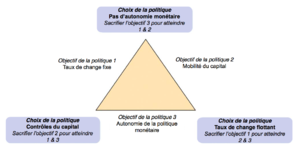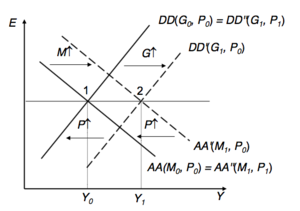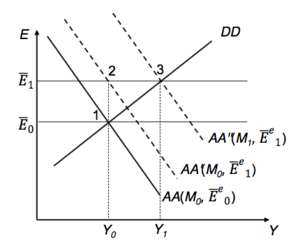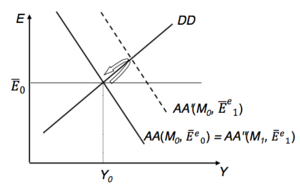« Fixed exchange rates and intervention on the foreign exchange market » : différence entre les versions
| Ligne 133 : | Ligne 133 : | ||
[[File:économie internationale taux de change fixes et interventions sur le marché trilemme économique de Mundell 1.png|thumb|center|Source: Feenstra&Taylor, 2008]] | [[File:économie internationale taux de change fixes et interventions sur le marché trilemme économique de Mundell 1.png|thumb|center|Source: Feenstra&Taylor, 2008]] | ||
= | = Stabilization policies = | ||
== | == Macro Policies in the Short Term == | ||
NB I: | NB I: In the following we will make the hypothesis that the fixed exchange rate regime is credible ⇒ <math>E = E^e = \bar {E}</math> | ||
⇒ Delta P = Delta P^* = 0</math> | |||
1. | 1. Expansionary monetary policy | ||
*<math>M</math>↗ ⇒ AA ⟶ | *<math>M</math>↗ ⇒ AA ⟶ AA' ⇒ <math>E</math>↗ ⇒ CB intervention | ||
* | *Currency sales ⇒ <math>M</math>↘ ⇒ AA' ⟶ AA to its initial position. | ||
* | *No impact except on <math>RI</math> (which ↘). | ||
2. | 2. Expansive fiscal policy | ||
*<math>G</math>↗ ⇒ DD ⟶ | *<math>G</math>↗ ⇒ DD ⟶ DD' ⇒ <math>E</math>↘ ⇒ CB intervention | ||
* | *Buying currency ⇒ <math>M</math> ⇒ AA ⟶ AA' until <math>\bar {E}</math> is restored. | ||
* | *Positive impact on <math>Y</math>, even more pronounced than with floating exchange rates. | ||
1. | 1. Expansionary monetary policy | ||
[[File:économie internationale taux de change fixes et interventions sur le marché politique monétaire expansive 1.png|thumb|center|]] | [[File:économie internationale taux de change fixes et interventions sur le marché politique monétaire expansive 1.png|thumb|center|]] | ||
In the IS-LM model, the displacement of the LM curve is to the right (<math>M</math>↗ initial) and return of LM to its initial position (<math>M</math>↘ ). | |||
2. | 2. Expansionary fiscal policy | ||
[[File: | [[File:international economics fixed exchange rates and market intervention expansive fiscal policy 1.png|thumb|center|]] | ||
In the [[The Keynesian approach and the IS-LM model|IS-LM model]], the shift is made to the right of the IS curve (<math>G</math>↗) and of the LM curve (<math>M</math>↗ ) to keep <math>E</math> and <math>R</math> constant (no crowding out!). | |||
== Politiques macro dans le long terme == | == Politiques macro dans le long terme == | ||
Version du 26 mars 2020 à 15:16
| Professeur(s) | |
|---|---|
| Cours | Economie Internationale |
Lectures
- Le modèle de Ricardo : différences de productivité comme déterminant du commerce
- Le modèle Heckscher-Ohlin : différences de dotations en facteurs de production comme déterminant du commerce
- Les économies d’échelle comme déterminant du commerce : au-delà de l’avantage comparatif
- Instruments de politique commerciale
- Les accords multilatéraux
- Les Accords de commerce préférentiel
- La Contestation du libre-échange
- Macroéconomie Internationale : enjeux et tour d'horizon
- Comptes nationaux et balance des paiements
- Les taux de change et le marché des changes
- Taux de change à court terme : l’approche par les actifs
- Taux de change à long-terme : l’approche monétaire
- Produit intérieur et taux de change à court terme
- Taux de change flottants
- Taux de change fixes et interventions sur le marché des changes
What are the features and benefits of the fixed exchange rate regime?
Under a fixed exchange rate regime, can the central bank still pursue an autonomous monetary policy?
What role for fiscal policy?
What happens if the central bank is unable to guarantee exchange rate parity?
The fixed exchange rate regime
Fixed exchange rates
Situations in which a country's exchange rate fluctuates little or not at all (administered fluctuations) against a base foreign currency = the government intervenes continuously to try to maintain parity → continuous interventions.
Why study fixed exchange rates?
Theoretical comparison with "pure" flexible exchange: advantages and disadvantages.
Historical interest
- 1870-1914: gold standard (price of currency fixed in terms of gold).
- 1945-1973: gold exchange standard (price of currency in terms of USD whose parity is defined in terms of gold).
Regional monetary arrangements (European Monetary System, EMS: 1979-1992).
Many developing countries peg their currencies to a "strong" currency (dollar or CFA franc), see the following table.
Since 1973: international monetary system is hybrid = floating exchange rate regime administered in many countries (> that the 3⁄4 of countries), cf. following table.
Details
Advantages of the fixed exchange rate
More transparent and simple.
More predictable: elimination of exchange rate risks and reduction of transaction costs for importing and exporting companies.
Advantageous for least developed countries where the financial system is not sufficiently developed to hedge against exchange rate risk in the long term.
For countries with weak institutions, and a monetary policy with little credibility (hyper inflation), it allows "importing" the credibility of a stronger central bank.
We will see in this chapter that all this choice depends on the cost of losing the autonomy of monetary policy.
Central bank interventions
Central bank balance sheet
Operation based on the principle of double writing
ASSETS
- RI = Foreign currency bonds held by the CB, including gold. Their level changes when the CB intervenes in the foreign exchange market (sale or purchase).
- A = Domestic or domestic assets. Claims of the CB on domestic institutions or banks. These are government bonds or loans to domestic private banks.
LIABILITIES (= CB's liabilities)
- CV = Private bank deposits. Private banks hold deposits at BCV to partially cover their own liabilities. This is a commitment on the part of the BC because private banks can withdraw sums from the bank when they need them (private individuals do not hold deposits at the BC: the BC is the "bank of banks").
- N = Currency in circulation. Commitment for historical reasons (at one time CBs had to hold a certain amount of precious metal - gold or silver) in case citizens wanted to exchange the national currency for gold.
Assumptions: ⇒
- Monetary base:
- Money supply: (where = money multiplier)
=> any change in the level of assets (including foreign currency) causes a change in the same direction of the money supply
Examples:
- BC buys an asset (and makes the payment either in cash (increase of ) or by crediting the giro account of the commercial bank concerned (increase of CV) ⇒ ↗ .
- BC sells an asset (for cash (decrease of ), or by debiting the giro account of the commercial bank concerned (CV decrease) ⇒ ↘.
Interventions on the foreign exchange market
Hypothesis: ↗ ⇒ on the money market: ↗ ⇒ ↗ ⇒ on the foreign exchange market: ES of currencies, so tends to ↘.
How do we prevent E? Purchase of currency by the CB ⇒ ↗ ⇒ ↗⇒ ↗ ⇒ ↘ until the interest rate returns to its initial level.
Consequence: intervention on the foreign exchange market leads to a ↗ of (and thus in the long run to a ↗ of ) = loss of monetary policy autonomy in fixed exchange rates.
Mundell's economic trilemma
The loss of control of the CB's monetary policy in fixed exchange rates is also known as Mundell's "trilemma" (or "impossible trilemma").
There are three possible policy objectives:
1. Stability in international interactions (fixed exchange rate):
2. Promotion of financial integration and efficiency (full mobility of capital ⇒ PTINC):
3. Economic stabilization policies (autonomy of monetary policy):
Clearly the three objectives cannot coexist and one of them must be sacrificed to achieve the other two.
Stabilization policies
Macro Policies in the Short Term
NB I: In the following we will make the hypothesis that the fixed exchange rate regime is credible ⇒
⇒ Delta P = Delta P^* = 0</math>
1. Expansionary monetary policy
- ↗ ⇒ AA ⟶ AA' ⇒ ↗ ⇒ CB intervention
- Currency sales ⇒ ↘ ⇒ AA' ⟶ AA to its initial position.
- No impact except on (which ↘).
2. Expansive fiscal policy
- ↗ ⇒ DD ⟶ DD' ⇒ ↘ ⇒ CB intervention
- Buying currency ⇒ ⇒ AA ⟶ AA' until is restored.
- Positive impact on , even more pronounced than with floating exchange rates.
1. Expansionary monetary policy
In the IS-LM model, the displacement of the LM curve is to the right (↗ initial) and return of LM to its initial position (↘ ).
2. Expansionary fiscal policy
In the IS-LM model, the shift is made to the right of the IS curve (↗) and of the LM curve (↗ ) to keep and constant (no crowding out!).
Politiques macro dans le long terme
NB I : Dans la suite nous allons faire l’hypothèse que le régime de change fixe reste crédible ⇒
NB II : Long terme ⇒ ⇒ →
Hypothèse: on part d'un équilibre de long terme (), puis :
- À court terme : passage du point au point (↗ et ↗).
- Comme , ↗ ⇒ AA et DD se déplacent vers la gauche, jusqu'à ce qu'elles se croisent à nouveau au point .
NB III : à long terme pas d’effet ni sur , ni sur , mais appréciation réelle (comme en changes flottants).
Dévaluations et crises de la balance des paiements
Dévaluation
En régime de changes fixes, la BC perd le contrôle de la politique monétaire, mais elle a en réalité un autre instrument d’intervention dans le système économique qui consiste à modifier le taux de change lui-même: dévaluation ou réévaluation de la monnaie nationale.
Au moins dans le court terme, une dévaluation de la monnaie nationale représente en principe un instrument de politique économique permettant de relancer l’économie et d’intervenir sur .
D’autre part, en régime de changes fixes, la BC peut être confrontée à des situations d’attaques spéculatives en cas de perte de confiance de la part des marchés sur sa capacité de défendre la parité: crises autoréalisatrices et dévaluations forcées.
Dévaluation intentionnelle
Hp : dévaluation crédible par la BC ( ⇒ passe de à
Court terme : comme ↗, AA ⟶ AA' et ↗ immédiatement à sa nouvelle valeur (point ). Mais, point = ⇒ ↗ ⇒ ↗ ⇒ ↗ ⇒ ↘
⇒ BC intervient en achetant des devises ⇒ (↗⇒ ↗) ⇒ déplacement additionnel de AA vers la droite ⟶ AA’'⇒ nouvel équilibre au point : ↗, ↗, ↗
Long terme ⟺ , ↗ ⇒ DD et AA se déplacent à gauche (non représenté) jusqu'à intersection au point ⟺ rétablissement de à sa valeur de long terme.
Dévaluation forcée
Manque de confiance dans la capacité de la BC à défendre la parité. Hypothèse: très basses ⇒ ↗ ⇒ la demande d'actifs étrangers ↗ ⇒ AA ⟶ AA' ⇒ a tendance à ↗.
⇒ Vente de devises par la BC (les agents privés se débarrassent de leurs avoirs en monnaie nationale = fuite des capitaux) ⇒ ↘ ⇒ ↘ ⇒ retour au point initial avec une hausse de .
Mais: dans l'intervalle, les ont diminué ! ⇒ Ceci renforce les anticipations de dévaluation : ↗ ⇒ nouvelle perte de ... jusqu'à la dévaluation forcée (crise auto- réalisatrice).
Résumé : changes fixes
Annexes
References
- ↑ Page personnelle de Federica Sbergami sur le site de l'Université de Genève
- ↑ Page personnelle de Federica Sbergami sur le site de l'Université de Neuchâtel
- ↑ Page personnelle de Federica Sbergami sur Research Gate
- ↑ Céline Carrère - Faculté d'économie et de management - UNIGE
- ↑ Céline Carrère - Google Scholar Citations
- ↑ Director Céline Carrère - Rectorat - UNIGE
- ↑ Céline Carrère | Sciences Po - Le Laboratoire Interdisciplinaire d'Evaluation des Politiques Publiques (LIEPP)
- ↑ Céline Carrere - EconPapers
- ↑ Céline Carrère's research works - ResearchGate














































